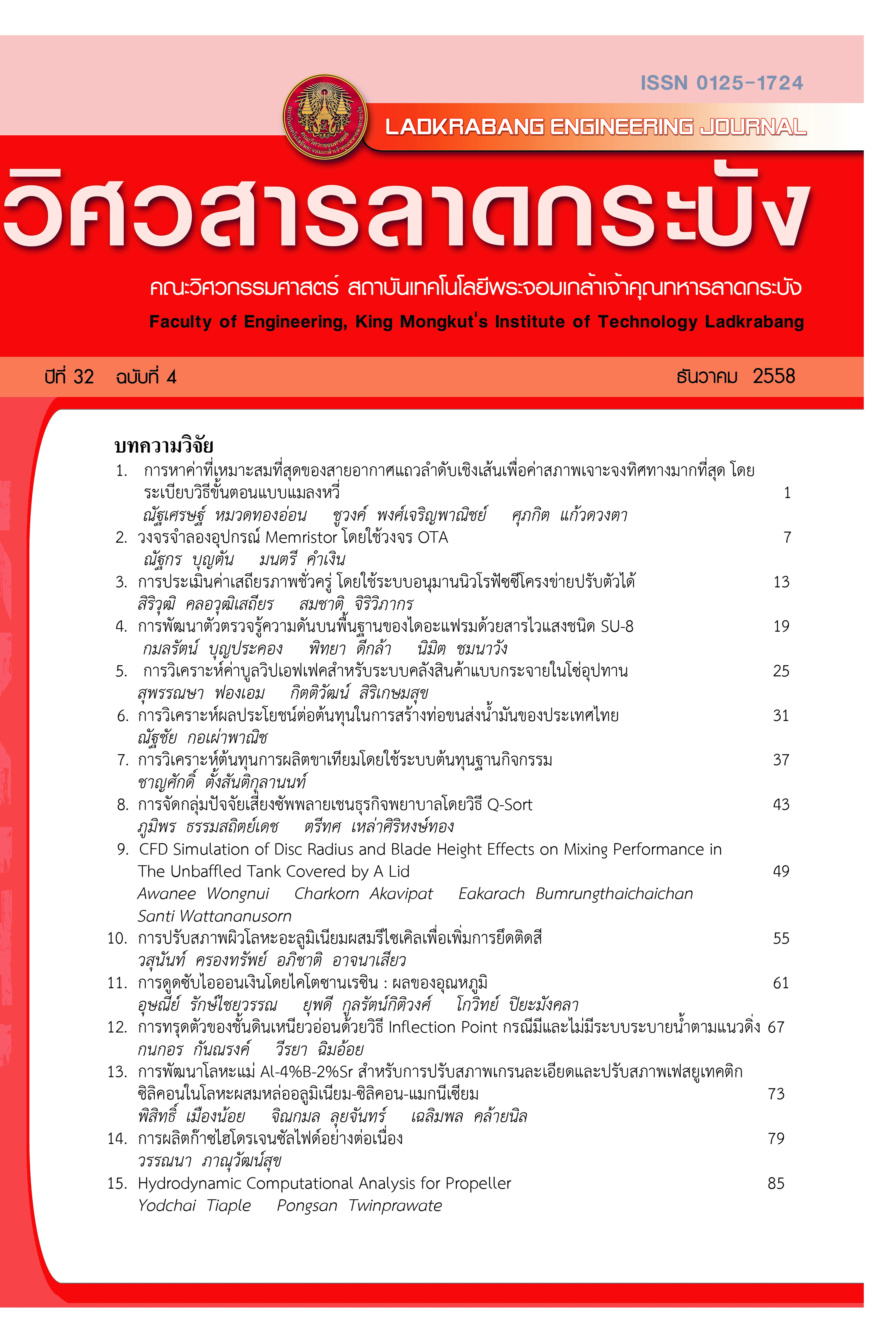Adsorption Silver Ion By Chitosan Resin: Effect Of Temperature
Keywords:
อุษณีย์ รักษ์ไชยวรรณ, ยุพดี กูลรัตน์กิติวงศ์, โกวิทย์ ปิยะมังคลาAbstract
The chitosan resin was used as adsorbent for the adsorption of silver ion in batch process. The effect of temperature was thoroughly investigated. It was found that increasing temperature of silver ion increased the adsorption capacity. The highest adsorption capacity of the chitosan resin was 17.7 mg/g. The change of enthalpy was endothermic reaction. The thermodynamics study revealed that changes in enthalpy, entropy and Gibbs free energy were 29.9 kJ/mol, 94.9 J/mol-K and -306.3 J/mol, respectively. The Gibbs free energy was negative value, suggesting spontaneity of adsorption process. The pseudo-second order model was fit for describing the kinetics adsorption behavior. The mechanisms of the adsorption occurred in 2 steps. The rate limiting step for mechanism of adsorption was film diffusion.
References
[2] C. Songkroah, W. Nakbanpote and P. Thiravetyan, “Recovery of silver-thiosulphate complexes with chitin,” Process Biochemistry, Vol. 39, pp. 1553-1559, 2004.
[3] W. Sripakdee and K. Piyamongkala, “Equilibrium chromium(VI) adsorption from electroplating wastewater by crosslinked chitosan resin,” The Journal of Applied Science, Vol. 8, No.2, pp. 6-21, 2009.
[4] N. Das “Recovery of precious metals through biosorption,” Hydrometallurgy Vol. 103, pp. 180–189, 2010.
[5] N. Ruengrong, M. Taewsub and K. Piyamongkala, “Adsorption direct blue 86 dye by chitosan and rice husk,” Ladkrabang Engineering Journal, Vol. 31, No. 3, pp. 55-60, 2014.
[6] V. Kittithawornkul, S. Aoonpoontarik and K. Piyamongkala, “Adsorption of cutting oil by synthetic acid soil,” The Journal of KMUTNB, Vol. 20, No. 2, pp. 266-277, 2010.
[7] J.W. Moore, W.G. Davies and R.W. Collins, Chemistry, McGraw-Hill, 1978.
[8] R. Suttanan and K. Piyamongkala, “Kinetics and thermodynamics of adsorption methylene blue by groundnut shell,” KMUTT Research and Development Journal, Vol. 31, No. 4, pp. 751-763, 2008.
[9] L. Jin and R. Bai, “Mechanisms of lead adsorption on chitosan/PVA hydrogel beads,” Langmuir, Vol. 18, pp. 9765-9770, 2002.
[10] C. H. Wu, “Adsorption of reactive dye onto carbon nanotubes: Equilibrium, kinetics and thermodyn amics,” Journal of Hazadous Materials, vol. 144, pp. 93-100, 2007.
[11] A. Ramesh, H. Hasegawa, W. Sugimoto, T. Maki and K. Ueda, “Adsorption of gold(III), platinum(IV) and palladium(II) onto glycine modified crosslinked chitosan resin,” Bioresource Technology, Vol. 99, pp. 3801-3809, 2008.
[12] J.U.K. Oubagaranadin, N. Sathyamurthy and Z.V.P. Murthy, “Evaluation of fuller’s earth for the adsorption of mercury from aqueous solutions: A comparative study with activated carbon,” Journal of Hazardous Materials, Vol. 142, pp. 165-174, 2007.
[13] D. Mohan and K.P. Singh, “Single-and multi- component adsorption of cadmium and zinc using activated carbon derived from bagasse-an agricultural waste, Water Research, Vol. 36, pp. 2304-2318, 2002.
Downloads
Published
How to Cite
Issue
Section
License
The published articles are copyrighted by the School of Engineering, King Mongkut's Institute of Technology Ladkrabang.
The statements contained in each article in this academic journal are the personal opinions of each author and are not related to King Mongkut's Institute of Technology Ladkrabang and other faculty members in the institute.
Responsibility for all elements of each article belongs to each author; If there are any mistakes, each author is solely responsible for his own articles.






